improveddevices.com
making things more useful
This hydrant is a worthwhile purchase particularly when you take into account the improved way it works, the ease of use, and less maintenance.
$229.99 for one hydrant
$220.79 each 2-4 hydrants -4%
$211.59 each 5-10 hydrants -8%
$202.39 each 10+ hydrants -12%
For local buyers (Northeastern Arizona) a $40 deposit for each hydrant gets your order started.
NEW TECH Yard Hydrant
Patent Pending
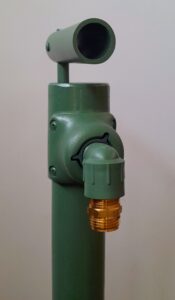
This improved device is the result of over five years of development and testing in situations where it’s actually used.
I use every opportunity to make refinements which improve the looks and the function of the NEW TECH Yard Hydrant without sacrificing quality while keeping the price as low as possible.

The bottom bury section is gray, as a general guide to bury depth. In our standard model moss green is the color on the above-ground section.
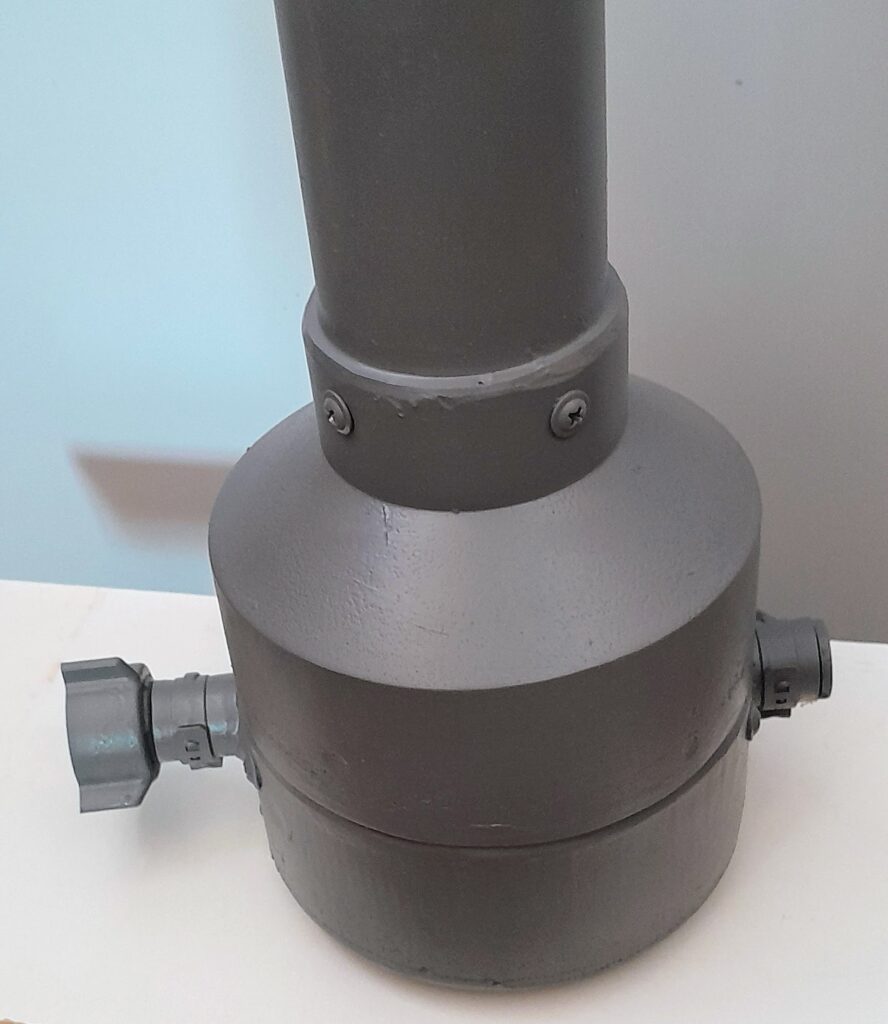
Water supply to the hydrant is attached at the 3/4″FNPT connector on the side of the valve housing not under the bottom of the hydrant.
The traditional pump-handle style hydrants have been around so long that a new type of hydrant might make you skeptical. But just imagine a year-round water hydrant for your outdoor plants and animals that’s more reliable and easier for everyone to use. That’s what I did, and the result turned out great.
What’s “new tech” in the NEW TECH Yard Hydrant?
Answer: the way it works and the materials used to make it.
Back up about a hundred years. Pump-handle style hydrants started being made and became commonly available. They were popular because they made it easier to get water closer to where it was needed year round for outdoor plants and animals. Over the years they’re what most people have used for that purpose. They are what’s familiar.
However, these traditional hydrants have had problems since the beginning. Their functional design requires that their parts and materials hold up under conditions which they were never meant to tolerate. The results: leaks, corrosion, stiff handle.
It’s a mystery why manufacturers haven’t made significant improvements as available parts and materials have greatly improved over the last hundred years. Never the less people keep buying them because they’re the only type of hydrant that’s available. So, companies keep making them. It’s a vicious cycle.
THAT BRINGS US TO TODAY
Improvements in parts and materials have made it possible to use a completely different and better functional design, which the NEW TECH Yard Hydrant does
The NEW TECH Yard Hydrant uses parts and materials suited to the job each one is asked to do. That means it doesn’t have the problems traditional hydrants have. To prove it to myself and for you I spent over five years in development and testing, using it in real-life situations.
Four major considerations have been addressed:
1.a completely different configuration of valve is used,
2.the materials used in the water containment pathway do not react when exposed to water,
3.the steel valve control rod, which would corrode and degenerate when directly exposed to water, is completely isolated from water, and
4.there is NO RUBBER anyplace, including the valve, thus eliminating all the problems from the wear and tear on rubber found in traditional hydrants.
You can probably guess the positive practical results in daily use.
Anyone with weak / painful hands can easily turn the hydrant handle “on” and “off”. It’s just a quarter turn side to side. Over time it does not stiffen.
There’s no leaking around the top compression gasket, because there is no compression gasket. It’s not needed. That means you don’t have to tighten down a compression nut until it won’t tighten any more, then finally spend money on a kit, with more parts than what you need, if it has the right part at all.
The valve control rod doesn’t degenerate and eventually fail from frequent or prolonged immersion in water, because it’s never immersed in water. It doesn’t touch water. So, you don’t have to dig up the hydrant and either replace the hydrant or the control rod.
You don’t have to worry about failure of the water delivery tube due to a thinned wall caused by corrosion from prolonged or frequent exposure to water. The water delivery tube is made of material which doesn’t degrade on exposure to water.
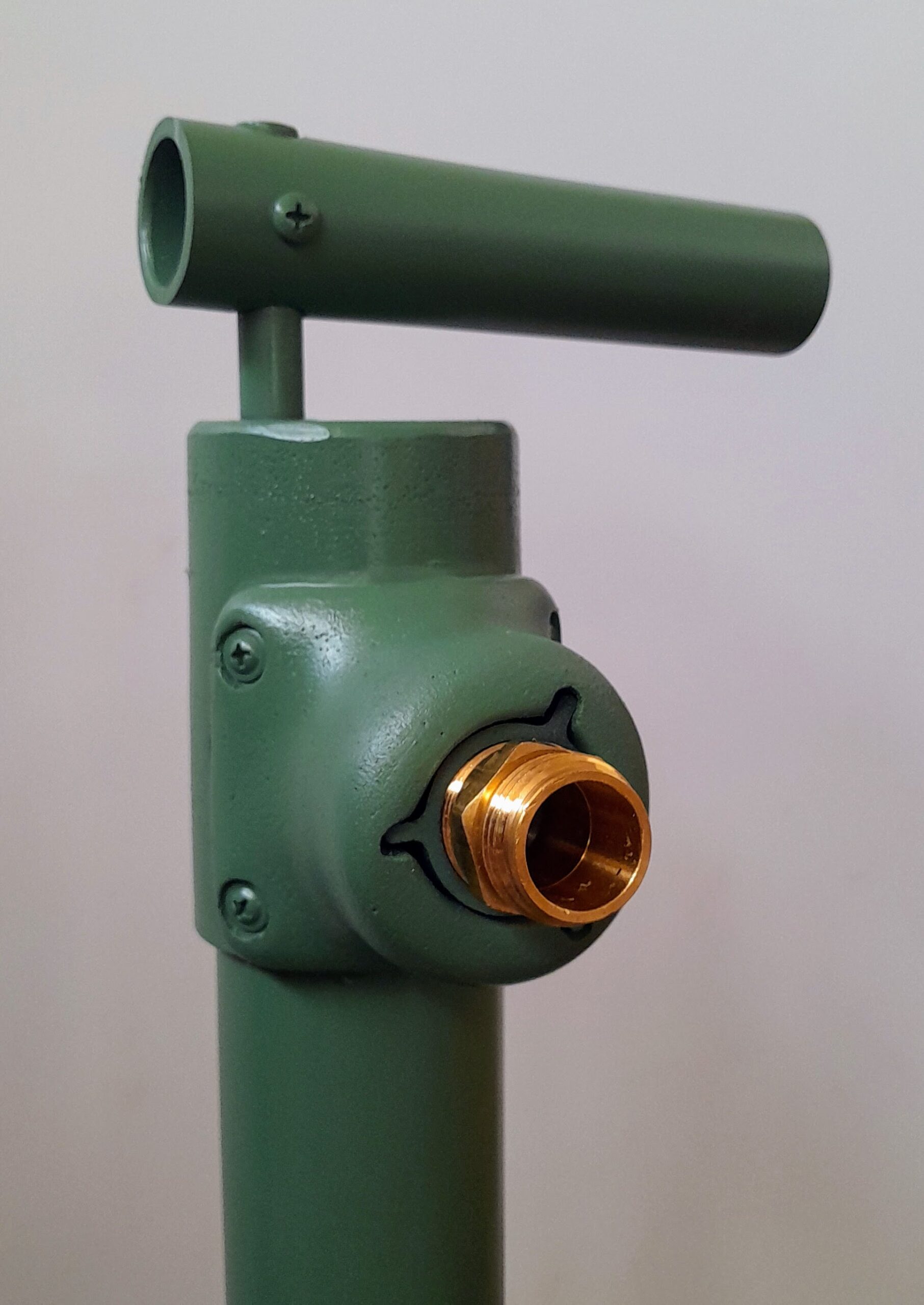
You can use the hydrant with or without the brass alloy hose adapter, and with or without the “street elbow”, a 90 degree elbow fitting. This photo shows it without the elbow.
Other Considerations:
NEW TECH Yard Hydrant minimizes wasted water when the hydrant is shut off and the water drains out. This is because of the smaller size of the watery delivery/drain-out tube. It doesn’t take a 1 1/4″ diameter tube to provide plenty of water in most circumstances. You don’t believe me? Look at the volume of water that comes out through a hole 3/4″ in diameter
Last but certainly not least is appearance. It has a clean pleasing appearance appropriate for use anyplace, from barnyard to finely landscaped yard. You don’t like the color? The material is easy to paint.
A beneficial lesson learned from traditional hydrants:
The brass alloy used in the valve of traditional hydrants is very resistant to degradation from contact with water. So, even though the valve in the NTYH is a completely different configuration, it’s made of that type of brass alloy, which has proven to be very reliable.
Water flow control:
The valve in the NTYH is NOT intended to regulate the volume of water flow. It is either on or off. The volume of water flow is controlled by whatever device you attach to the hydrant, like a hose with a nozzle. Turn the hydrant either completely on or completely off.
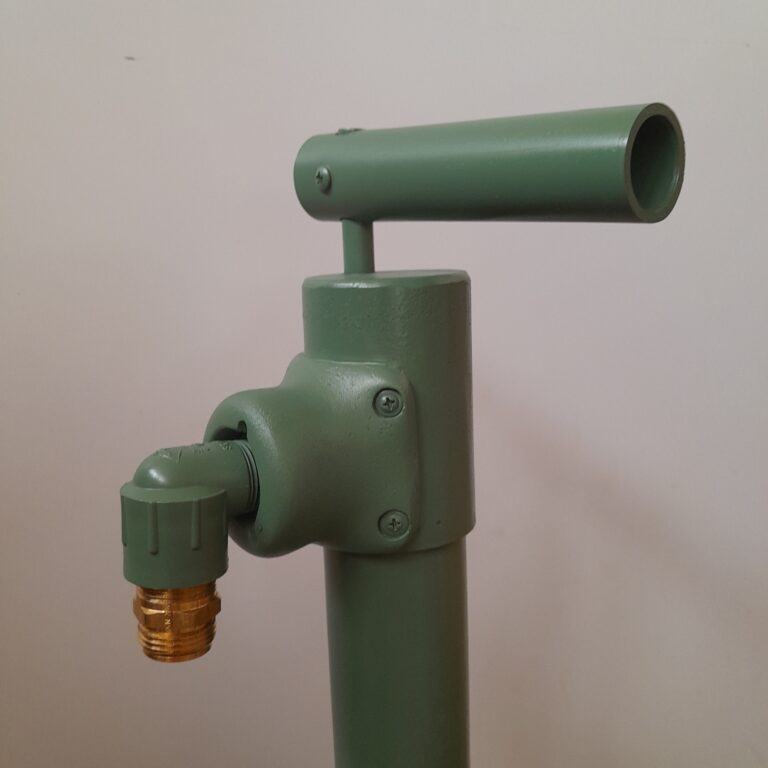

The handle provides comfort and ease of use.
I tried many other more “sophisticated” and stylish options for the handle shape but came back to the simplicity of the short tubular handle because of how well it works and how good it feels.
It’s one inch diameter UV protected schedule 40 non-metallic PVC conduit, six inches long.
We’ve never hand a problem with pests using the hole through the handle as a home, but if you’re concerned about the open tube, just poke some cheap steel wool in it or even use a bit of expanding foam.
DURABILITY & PERFORMANCE
The outside protective tube of the hydrant is made of tough rigid, UV protected, 2” diameter PVC with 3/16” thick walls. It’ll hold up to just about any type of common use and abuse. BEWARE – Locating ANY hydrant inside a stock pen or where a vehicle can run over it is not good idea.
Different types of rigid and flexible plastic have been selected to do different jobs through out the NEW TECH Yard Hydrant. None of them react or degrade from contact with water, dirt, or just about anything else. It should last a long time under normal use.
The NTYH works well at pressure as low as 20psi. We use 35 to 55psi. 90psi shouldn’t be problem. Any higher psi is very hard on any type of plumbing elements.
BURY DEPTH
Our standard length hydrant is designed for the bottom of the valve housing to be buried between 20 and 30 inches deep. The NEW TECH Yard Hydrant measures 47 ½ inches from the bottom of the valve housing to the water outlet, so you can bury it up to a depth of 30″ and still have room to place a five gallon bucket underneath the water outlet.
If you need something longer for a deeper bury depth, it can be made, but expect an additional charge for design time and added materials. I require a signed contract with all the details before I do a custom hydrant.
For any yard hydrant used in an area with seasonal freezing:
The bottom of the hydrant, where the valve is located, needs to be buried below the frost penetration line. This depth varies depending on the area where you’re using it. See the map below for a general idea.
This map shows general frost penetration depths across the continental USA. For anyone who buys any frost proof yard hydrant check, with your local building department to make sure of the specific bury depth you need.

A Note About Stabilizing Your Hydrant:
When you install your yard hydrant keep in mind where you’re going to locate it and how you’re going to use it. With frequent use and lots of rough treatment it’s a good idea to stabilize it, not just put it into the ground free standing. Some people use cement, but that makes any future changes very difficult. I do not recommend it.
DO NOT drive a t-post into the ground up against the outer protective tube of the hydrant. At the bottom the valve housing flares out. Pounding a hole through it with a t-post may damage not only the housing but also the valve itself. That IS NOT covered by warranty.
Frequent use without stabilizing it, no matter the type of yard hydrant, including the NEW TECH Yard Hydrant, is more likely to lead to problems. This is especially true in soil which doesn’t compact well. The photo below shows one way of stabilizing a hydrant which works well, although the method could be a little cleaner looking.
Detailed installation and use instructions for the NEW TECH Yard Hydrant are included on the purchase/warranty receipt you receive with the hydrant. Much of it applies to the installation of almost any frost proof yard hydrant.
The story behind the NEW TECH Yard Hydrant
In short, the final straw was my wife’s hands. They got to the point where she could not raise and lower the handle of the old pump-handle style hydrant because of pain and weakness when she tried. But let’s back up a bit.
It’s exciting to move onto a bare piece of land with just a dream in hand. Then it turns into work. Once you have animals, there’s feeding and watering, and everything else that goes into taking good care of them. There’s the big garden. There’s also a small orchard, if forty-eight fruit trees is all that small for a “small” place.
Everything human, animal, and plant needs water. Water for the house is one thing, and it has it’s own set of challenges. Water for the animals and plants is something else entirely.
To get water where we need it we use frost proof yard hydrants. Like everyone else in our shoes, we purchased and installed the old fashioned ones with the pump-handle style handles, the ones that raise up to open and push down to shut off.
It wasn’t long before the hydrants started to leak around the compression gasket at the top, around the valve control rod. There’s no problem getting water. It’s just a nuisance. For a few times you can tighten down the nut on the compression gasket to stop the leak, or at least slow it down. So everything is fine for a while, but it gets worse with use over time.
The hydrant in our barn gets turned off and on four to six times a day, mostly in the morning. The one for the garden and orchard basically is turned on in the spring and off in the fall, but only has water flowing to irrigate specific places at specific times. The one for the buck pen is turned off and on once a day. The one located half way between the house and the well is used maybe twice a week during the spring and summer. In short, we use our frost proof yard hydrants in a number of places and in different ways throughout the year.
After a while the hydrants which are turned off and on the most and the ones which are turned off and on the least start to have problems, although different types.
The hydrant in the barn stopped working properly on a couple of different occasions and I had to dig it up to fix it. In the process I discovered that the rod connecting the handle at the top to the valve at the bottom was corroded so badly it wouldn’t be long before it failed. The inside of the main pipe was so rusted it probably wouldn’t be long before it also failed. (The repair man at the local hardware store said he commonly found the same things when people brought in their yard hydrants to get fixed.)
The hydrant for the garden and the orchard, after being left off during the fall and winter, was so stiff that my wife had a very difficult time even trying to turn it on. It got to the point where she couldn’t. I had to do that for her.
So, I finally gave up trying to fix the old style hydrants and started looking for a better way to build a yard hydrant. In casual conversation with a neighbor one afternoon he made a comment wondering why smaller water lines didn’t have valves which shut off like larger city water lines. The valve is a simple one which you turn by using a long rod with a device on the end which has notches that insert over protrusions on the valve. You reach down into the hole, where the valve is located, insert the notches on the end of the rod into the valve handle and turn. With that idea the direction for the development of a new type of frost proof yard hydrant began in earnest.
Such a simple idea, right? That was over five years ago and it hasn’t been as simple as it might seem to solve all the problems to make the idea into something simple and reliable which works for a yard hydrant.
After many ideas have been tried and tested using many prototypes there is now a frost proof hydrant which eliminates virtually all the problems of the old style hydrants, and has additional benefits. It’s the NEW TECH Yard Hydrant.
One way to stabilize your hydrant.
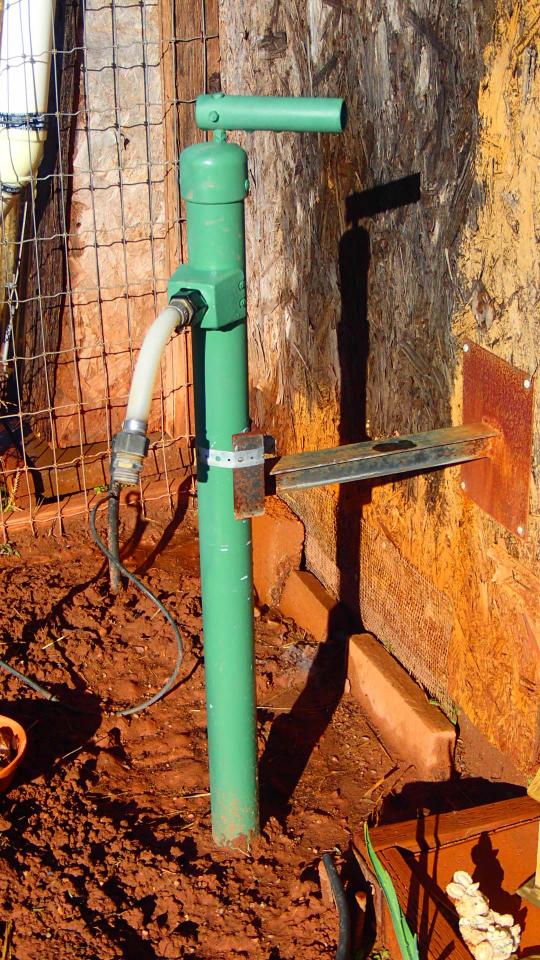
This is an earlier model of the NEW TECH Yard Hydrant installed next to the garlic bed. You can see the stabilizing arm attached to the building.